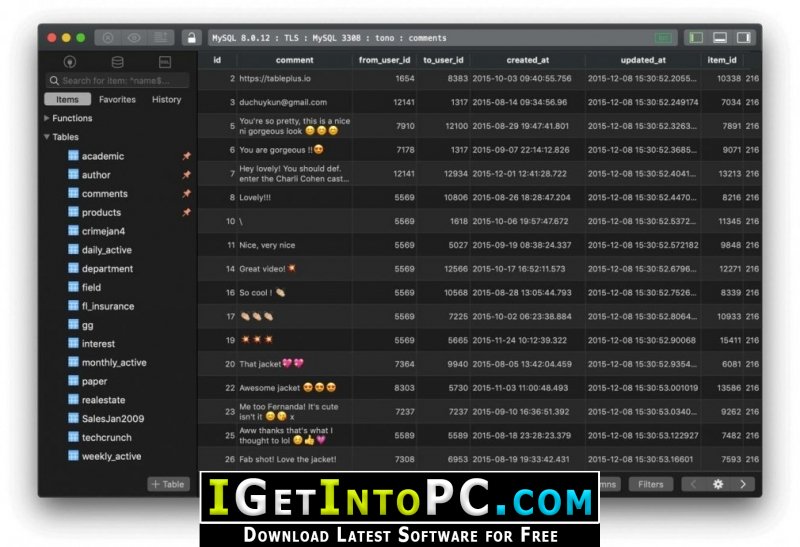

- TABLEPLUS EXPOR TABLE INSTALL
- TABLEPLUS EXPOR TABLE ARCHIVE
- TABLEPLUS EXPOR TABLE FULL
- TABLEPLUS EXPOR TABLE REGISTRATION
It has the same value as CustomizedSyncInterval (if set) if it is not more frequent than AllowedSyncInterval. You cannot synchronize more frequently than this setting and still be supported. The shortest time interval between synchronization cycles allowed by Azure AD. If you see this error, then run Import-Module ADSync to make the cmdlet available. This problem could happen if you run Azure AD Connect on a domain controller or on a server with higher PowerShell restriction levels than the default settings. If you see The sync command or cmdlet is not available when you run this cmdlet, then the PowerShell module is not loaded. It shows you something like this picture: To see your current configuration settings, go to PowerShell and run Get-ADSyncScheduler. This also applies to servers in Staging mode.
TABLEPLUS EXPOR TABLE FULL
A delta sync (following a full sync) needs to happen within 7 days from the time the last full sync completed.įailure to do so may cause synchronization issues which will require you to run a full synchronization to resolve.A delta sync needs to happen within 7 days from the last delta sync.If you have modified the synchronization cycle you will need to make sure that a synchronization cycle is run at least once every 7 days. For example, if you need to have your own synchronization cycle process, you can disable this task in the scheduler but still run the maintenance task.īy default every 30 minutes a synchronization cycle is run. The scheduler itself is always running, but it can be configured to only run one or none of these tasks.
TABLEPLUS EXPOR TABLE REGISTRATION
Renew keys and certificates for Password reset and Device Registration Service (DRS). The process to import, sync, and export changes. The scheduler is responsible for two tasks: The new default synchronization frequency is 30 minutes. The scheduler is with the 1.1 releases built-in to the sync engine and do allow some customization. It used Windows task scheduler or a separate Windows service to trigger the synchronization process. In earlier releases, the scheduler for objects and attributes was external to the sync engine.

There are two scheduler processes, one for password sync and another for object/attribute sync and maintenance tasks. OverviewĪzure AD Connect sync synchronize changes occurring in your on-premises directory using a scheduler. This feature was introduced with build 1.1.105.0 (released February 2016).
TABLEPLUS EXPOR TABLE ARCHIVE
To view the data in an archive file, you will need to restore the file to a database.This topic describes the built-in scheduler in Azure AD Connect sync (sync engine). tar) to save space and make exporting quicker. If you’re working with a large database, you may want to export the database as an archive file (e.g.dump or. TextEdit, Notepad++, Sublime Text, etc.) or a database tool like TablePlus to review the exported data. export.sql) will be available at the path you specified in the pg_dump command. Once the export is complete, your database file (e.g. When prompted, enter the database password. Replace export.sql with the path and name of the database you want to import: psql -h EXTERNAL_HOSTNAME -U USERNAME -p PORT -d DATABASE_NAME export.sql Use the following command to export the database, replacing EXTERNAL_HOSTNAME, USERNAME, PORT, and DATABASE_NAME with the information from your database’s External connections. You can find your database credentials under External connections on the database Info page.
TABLEPLUS EXPOR TABLE INSTALL
Use the PostgreSQL Yum repository and install the postgresql-client. RedHat-based Linus (RedHat Fedora, CentOS, etc.) Use the PostgreSQL APT repository and install the postgresql-client. With Homebrew, replace XX in the following command with the version of PostgreSQL you want to install: brew install Debian-based Linus (Debian, Ubuntu, Mint, etc.) Windowsĭownload and install the GUI installer or binaries for the Interactive installer by EDB. Depending on your operating system, you can install PostgreSQL in the following ways. If you do not yet have PostgreSQL installed on your local machine, you’ll need to install it to connect to your database.


 0 kommentar(er)
0 kommentar(er)
